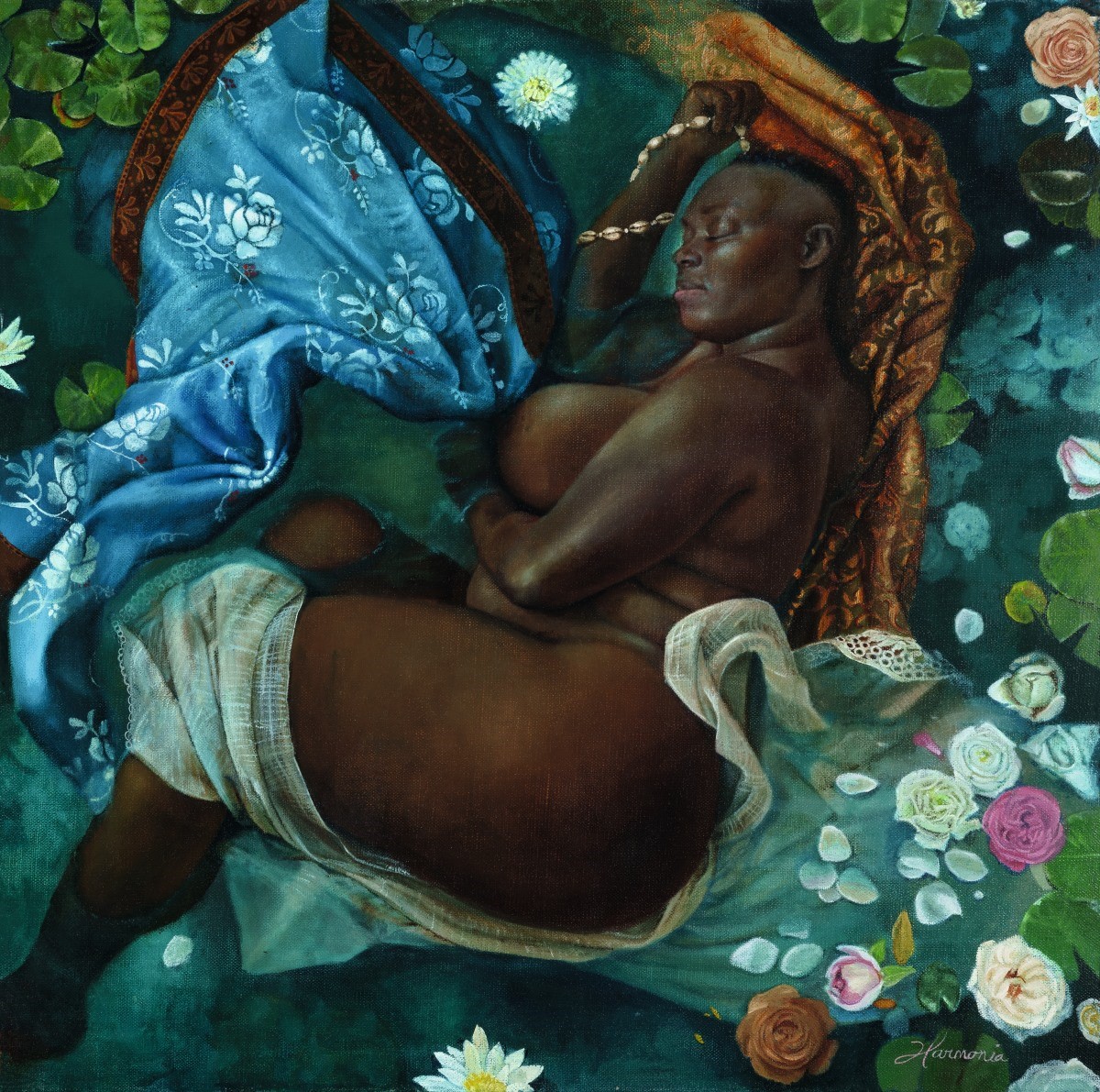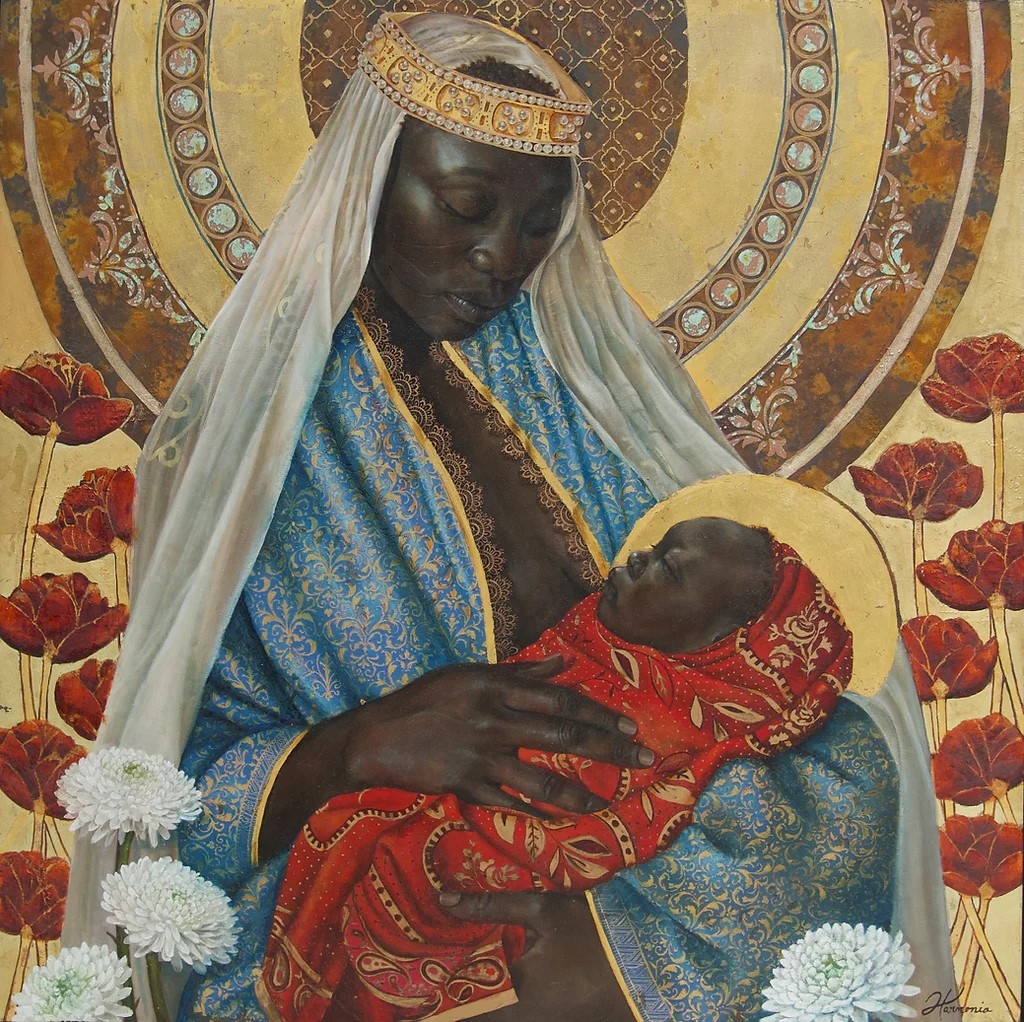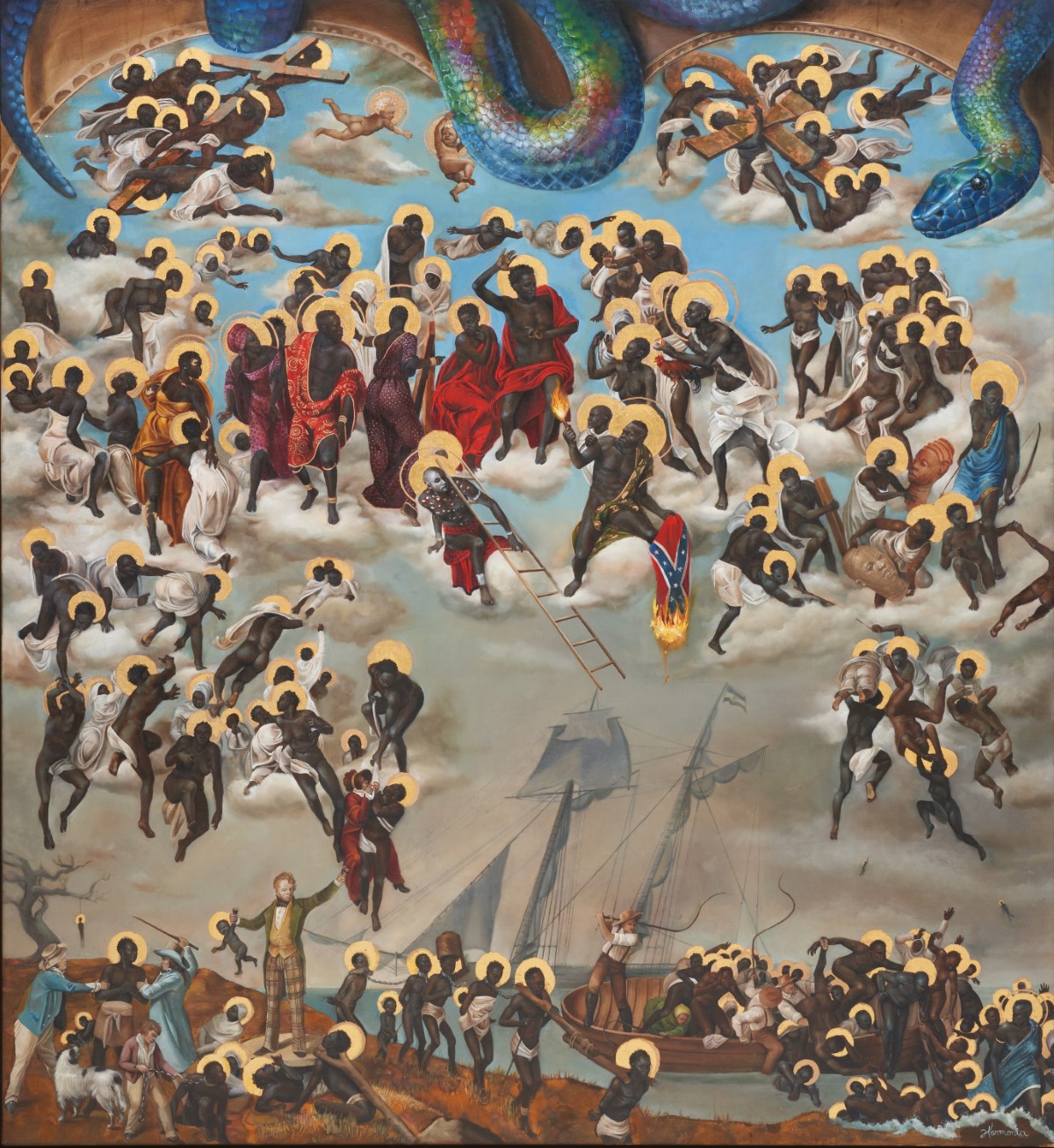Powerful Oil Paintings Modeled on the Work of Old Masters Give a Voice to African Mythology [Interview]

“Beyond the Peonies,” 36 x 48, Oil on Wood Panel and Canvas, 2021. Courtesy of Harmonia Rosales.
In her exhibition Master Narratives, Afro-Cuban American artist Harmonia Rosales seamlessly entwines the tales and characters of the Yorùbá religion, Greco-Roman mythology, and Christianity with the canonical works and artistic techniques of European Old Masters. Through her 20 oil paintings and a large-scale installation reminiscent of Michelangelo's Sistine Chapel ceiling, Rosales is spotlighting oft-forgotten narratives where Black voices take center stage.
In doing so, she's hoping to give her community a space where they see their reflections in the Orishas. These deities of the Yorùbá religion are painted with the same care that the masters of the Italian Renaissance gave their subjects. Now on view until December 2 at the Spelman College Museum of Fine Art in Atlanta, visitors are invited to immerse themselves in a world five years in the making.
In the Birth of Oshun, modeled on Botticelli's classic the Birth of Venus, Rosales incorporates rich Yoruba symbolism and explores themes of Black female empowerment. With the Creation of God, she subverts Michelangelo's Creation of Adam by depicting a Black woman as the first human. Instead of the Eurocentric view of God, Rosales places a woman in this position. In doing so, she challenges us to think about our own accepted views of beauty and power norms.
But perhaps the crowning jewel of Master Narrative is Rosales' reimagining of the Sistine Chapel ceiling. Here, for the first time, she's tackled sculpture by installing the piece across the hull of a slave ship. It's a moving piece that puts visitors, regardless of race, in a position where they are forced to confront this part of American history.
We had the chance to speak with Rosales about Master Narrative and her love for Old Master paintings, as well as her dedication to sharing Yorùbá mythology with a wider audience. Read on for My Modern Met's exclusive interview.

What inspires you about the art of the Old Masters, and how does this type of art serve your creative vision?
My artistic journey has always been greatly influenced by the Old Masters ever since I admired them in museums as a child. Their works were always such a magnificent and awe-inspiring display of intricate detail, symbolism, and storytelling. It truly provided a foundation upon which I've built my creative vision of how I wanted to reveal these ancient stories of the African gods.
My works, although figurative and realistic, have abstract symbolism, reminiscent of the Old Masters, but with a distinctive touch of African aesthetics and mythology. The Orishas, deities of the Yorùbá religion that have been “synchronized” to Catholic saints during times of oppression, are central to my art, as well as “Eve” who represents the ancestors who were enslaved and brought to America.
I seek to unmask the Orishas from their Catholic masks by presenting their true forms using the very medium that was once imposed on our enslaved ancestors.

“Creation of God,” 48 x 60, Oil on linen, 2017. Courtesy of Harmonia Rosales.

“Creation Story,” 48 x 72, Oil on wood panel, 2021. Courtesy of Harmonia Rosales.
Michelangelo is clearly a big inspiration. Can you share what the process of recreating his Sistine Chapel ceiling was like for you?
Michelangelo's work on the Sistine Chapel has definitely left a mark on my artistic journey. The way he captured the essence of key biblical stories, painting a vivid picture of Catholicism's concepts of heaven and hell, resonated deeply with me. I sought a similar approach in my latest installation, Master Narrative, to explore African history through the imagery of Orishas.
Drawing from Michelangelo's narrative style, I embarked on a five-year journey to create a body of work that encapsulates the creation myths and stories pertinent to African culture and history. From the creation of the world by Orishas to the creation of Eve and her life through the Atlantic slave trade, each painting was a piece of a larger puzzle, summarizing key elements from the Yorùbá religion and ancestral history, including the tragic period of the Atlantic slave trade.

(continued) For every exhibition over five years, I displayed a new piece of the puzzle. This gradual unveiling of the grand narrative provided me with valuable insights into the direction of the final work. I made sure each painting was crafted with as much love, care, and attention to detail as Michelangelo devoted to his masterpiece.
However, upon completing the final pieces, I found myself facing an unexpected challenge—how best to display this series of paintings. My initial thought was to recreate a church chapel, but I soon realized that this would only further tether the Orishas to their Catholic saint counterparts.
In a moment of revelation, as I pieced the paintings together, I noticed they formed a shape reminiscent of the undercarriage of a slave ship—a poignant symbol of the painful history of slavery. This unexpected connection sparked a creative solution. By displaying my Master Narrative on a representation of a slave ship's undercarriage, I could evoke the painful history of slavery while simultaneously reclaiming and celebrating the resilience of the Yorùbá religion.

“Yemaya Meets Erinle,” 48 x 36, Oil and iron oxide on Belgian linen, 2019. Courtesy of Harmonia Rosales.

“Yemaya Ascension into the Waters,” 20 x 20, Oil on linen, 2019. Courtesy of Harmonia Rosales.
Can you share a bit about the Yorùbá religion and why it was important for you to share these stories?
Introduced to the Yorùbá religion by my late Afro-Cuban grandmother, it has always held a profound significance for me. Unlike many faith traditions that center around a single Messiah or Chosen One, Yorùbá offers a unique perspective where everyone is seen as their own chosen one, the architect of their fate. The Orishas—divine beings embodying elements of nature and facets of the human psyche—exist not to rule over us but to guide and assist us in fulfilling our destinies.
Yorùbá's stories and teachings, I believe, are as ancient, if not more so, than those of Greek mythology and Catholicism. They weave a rich tapestry of interconnected narratives that are deserving of wider recognition and inclusion in our global historical discourse.
My artistic endeavor is an attempt to bring these overlooked narratives into the spotlight. It is my sincere belief that when we feel seen, recognized, and acknowledged, we can experience empowerment and healing—both individually and collectively. This is not just art for art's sake. It's a celebration, a reclamation, and a call to action.

“Our Lady of Regla,” 40 x 40, Oil, iron oxide, and 24k gold on wood panel, 2019. Courtesy of Harmonia Rosales.

“Birth of Oshun,” 55 x 67, Oil and iron oxide on Belgian linen, 2017. Courtesy of Harmonia Rosales.
How did becoming a mother influence your art and the types of stories that you want to tell?
Becoming a mother was akin to being reborn. It opened my eyes, enabling me to perceive the world through the pure and innocent gaze of my child. As a mother from an Afro-Cuban background, I felt a deep-rooted desire to shield my daughter from ever feeling less than her true worth in a society that often overlooks the beauty of ethnic heritage.
This maternal instinct spurred me to use my art as a powerful tool for change. I devoted myself to painting a world where my daughter—and anyone from our community—could see themselves reflected in all their natural glory. I wanted to create a universe in which they would not just feel included but celebrated.
The power of seeing oneself depicted in divine forms cannot be overstated. It can have a transformative impact on one's self-esteem, fostering a deep sense of pride in one's identity. It is a potent affirmation that we, too, are worthy of being portrayed as divine beings, embodying grace, strength, and beauty.
In conclusion, my art is not just about creating visually appealing pieces; it's about painting a world where my daughter, and others like her, can see themselves as divine, as beautiful, and as chosen. It's about using art as a force for change, a catalyst for empowerment, and a platform for social justice.

“Ascension of a Woman,” 51.5 x 41, Oil on linen, 2018. Courtesy of Harmonia Rosales.

“Still We Rise,” 60 x 55, Oil, iron oxide, and gold on canvas, 2021. Courtesy of Harmonia Rosales.

“Migration of the Gods,” 36 x 72, Oil, iron oxide, and 24k gold on Belgian linen mounted on wood panel, 2021. Courtesy of Harmonia Rosales.
How do you hope that visitors to the exhibition take away from the work?
When visitors step into my Master Narrative exhibition, I want them to embark on a journey. A journey that transcends the confines of the gallery walls and transports them into a world rich with untold stories, unexplored histories, and underrepresented narratives.
As they journey through the exhibition, I want visitors to feel a sense of connection—with the art, with the stories, and ultimately, with each other. I want them to reflect on the power of art as a tool for social change, and the role they can play in amplifying these stories in their own circles.
I hope that each visitor will leave my exhibition carrying a seed of curiosity, a spark of inspiration ignited by the stories embedded within my artwork.
I hope to inspire future leaders, thinkers, and creators to continue this conversation, to challenge the status quo, and to champion the power of diverse representation in all walks of life.



What are you working on next?
I've reached a juncture in my artistic journey where I find myself continually narrating the stories encapsulated within my paintings. It seems many who are captivated by my work aren't entirely familiar with the narratives they represent.
These tales, steeped in the Yorùbá religion, have been traditionally passed down orally through generations. Their preservation in spoken form was a strategic measure to ensure their survival during periods when foreign religions were forcefully supplanting indigenous beliefs.
With this in mind, I am currently immersing myself in a new series that delves deeper into these ancient Yorùbá narratives. This project, entitled Transformations, will offer a more profound exploration of these stories. In parallel, I'm also penning a book that will bring these mythologies to the written page, making them more accessible and allowing their wisdom to resonate with a broader audience.
0 Commentaires